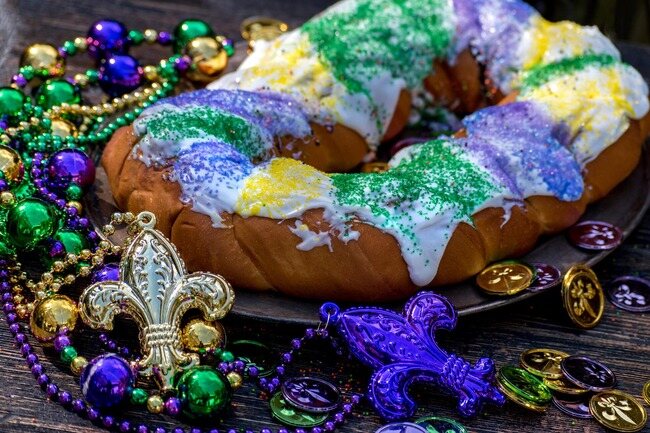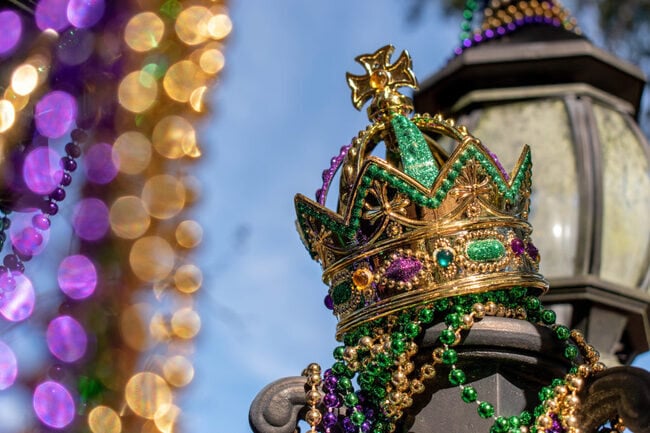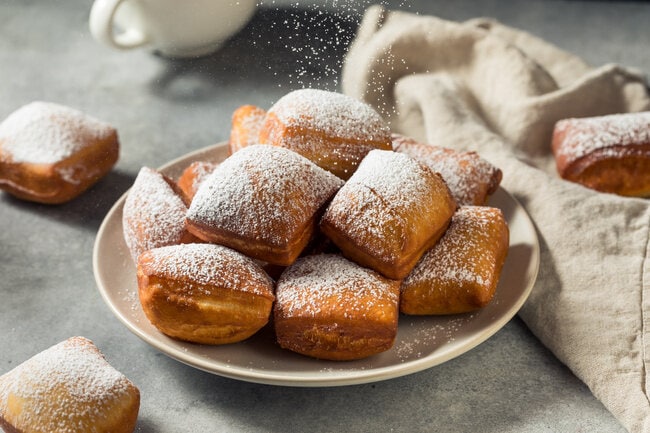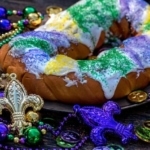When Is Mardi Gras 2025? History & Traditions

Mardi Gras is Tuesday, March 4, 2025. Learn about the history, traditions, and folklore behind this fun festival of fabulous food, including King Cakes and beignets!
Mardi Gras is a holiday of carefree celebration that precedes a time of solemn prayer and fasting known as Lent. Mardi Gras marks the culmination of “Carnival”—a festive season that begins on the Twelfth Day of Christmas, January 6, and traditionally serves as a counterbalance to the ceremonious forty days before Easter.
Mardi Gras History
Mardi Gras dates back thousands of years and is celebrated in many countries around the world, predominately those with large Roman Catholic populations. The origins can be traced to medieval Europe, with popular theories tied to the ancient pagan celebration of Saturnalia and Lupercalia, for Spring and fertility, which involved days of dancing, feasting, drinking, and masquerading.

Once Christianity arrived in Rome, religious leaders blended the traditions, turning it into an opportunity to enjoy excess and use up fatty and perishable foods before the abstinent period of lent. Along with Christianity, The Roman tradition traveled to other European countries, including Germany, Spain, England, and France where it acquired its name “Mardi Gras,” meaning “Fat Tuesday.”
The first Mardi Gras celebration in the United States took place on March 3, 1699, after French settlers landed near present day New Orleans. Mardi Gras festivities began in New Orleans soon after its founding in 1718, surviving Spanish control and attempted restrictions from the United States. They eventually accepted the festival’s presence, and the first street parade was recorded when the Big Easy became a major metropolis in 1837.
Who Celebrates Mardi Gras?
Although The Big Easy (New Orleans) is the epicenter of Mardi Gras, countries all over the world celebrate the Carnival season, each with its own twist. The French settlers in Mobile, Alabama, also feasted and masqueraded as part of Mardi Gras celebration. Many claim that Mobile stands as the oldest annual celebration in United States History.
Many other cities around the world are also noted for their Carnival celebrations, including Venice, Italy, and Rio de Janeiro, Brazil. Mardis Gras is known by many different names around the world, including Shrove Tuesday in the United Kingdom and Canada, Paçzki Day among Polish immigrant communities, and Fasnacht Day in areas with large German-immigrant populations, such as Pennsylvania Dutch Country.
The Foods of Mardi Gras
In addition to parades and parties, many Mardis Gras traditions involve special foods. The most common of those in this country is the eating of pancakes, doughnuts (paçzki), or other sweet pastries. The reason for such traditions is that only the simple foods are supposed to be eaten during Lent, and rich ingredients such as eggs, milk, and sugar must be used up of before the fast begins. Pancakes and doughnuts were seen as an easy way to up perishable goods so they wouldn’t spoil.
While the tradition of eating rich foods on Shrove Tuesday is widespread throughout Europe, it is most strongly associated with the United Kingdom, where Shrove Tuesday is commonly referred to as “Pancake Day.”
If Not Pancakes, How About King Cakes?
The King Cake is a staple for all Mardi Gras celebrations and is a heavenly treat for New Orleanians. Making its way to New Orleans in the 1870s, this cinnamon dough cake is rich with European and Roman Catholic roots. The name “King Cake” comes from the biblical story of the three kings who offered gifts to baby Jesus.
A mix between coffee cake and a cinnamon roll, the oval shaped cake symbolizes the unity of faiths. Traditionally, the cake is cinnamon-flavored dough covered in sweet, green, gold, and purple icing and filled with fruit and decadent cream cheeses. Special surprises are hidden within, such as a plastic baby, symbolizing baby Jesus. Whoever finds the plastic baby in their slice is said to have good luck and becomes “king” or “queen” for the night. He or she must also either bring next year’s cake or throw a party, continuing the cycle of food and merriment.
Bakeries and supermarkets are always eager to begin offering this seasonal treat, which can be found city-wide during the Carnival season. Not a local? Many bakeries offer fast deliveries across the country or even try your hand at making your own.
Try this recipe (via NewOrleans.com).
What Are Beignets?
New Orleans is known for many foods, but nothing says “Mardi Gras” quite like beignets (ben-yays), originally called “French Market Doughnuts” and rebranded as “beignets” in 1958. These humble puffy pastries are an iconic NOLA treat. Pillowy and sweet, beignets are perfectly deep-fried dough dusted with powdered sugar. They are traditionally served for breakfast, along with a café au lait (coffee with milk), however may be enjoyed any time of the day.
Beignets originated in France, where they are known as “fritters” or “little friend things,” and were brought to New Orleans by French-Acadian settlers in the 18th century. Christian Europeans have long enjoyed fried dough, a rich and fatty food, for Shrove Tuesday, prior to abstaining during Lent.

Not to be confused with a traditional doughnut, beignets are fluffy, airy, and super tender. Square and hole-less, they are made with more yeast and fewer eggs than a typical doughnut, resulting in a puffier, softer middle. Beignets are occasionally dipped in chocolate or caramel sauce, whereas doughnuts don a variety of fillings and toppings.
A fixture of New Orleans found at most cafes, restaurants, and street vendors, they became the Louisiana state doughnut in 1986. Café Du Monde was the first to serve beignets in New Orleans, initially opening their doors in 1862 and now serve the long lines of people waiting to savor their perfect trio. Why are they served in threes? It may be safe to assume that the number is a reference to the Holy Trinity. Beignets are a delicacy not to be missed on Mardi Gras, or any other time of the year. Tres delicieux!
Join The Discussion
How do you celebrate Mardi Gras?
Have you ever eaten king cake or beignets before?
Share your experience with our community in the comments below!





What a beautiful explanation of Shrove tuesday. I love your positive articles especially this one. Looking forward to more, especially Ash Wednesday including Lent. These are such special time for the readers that devote their time to follow these worthwhile traditions. I love you Farmers Almanac.
Thank you, Alma. We appreciate your comments. You can read about Easter here
The first organized Mardi Gras parade was held in Mobile, Alabama. The key word is organized, which makes it the official original Mardi Gras celebration held in 1703. It moved to what is now New Orleans after that in the 1800s. However, Mobile is the original home of Mardi Gras celebrations.
I am so glad that I decided to read full article. Very , very interesting info ,,I have not heard before. Thank you and Farmer’s Almanac.
I enjoyed reading this, Thanks for sharing.
For all those talking dates and history check your facts. March 3, 1699 and here’s a hint…First US Mardi Gras….NOT in Mobile.
I was invited to Mobile a few years back for Mardi Grad.I had never been to a ball before. We stayed at the Plaza Hotel. Navy ships from NATO nations were in port. We met interesting sailors from around the world. Although I didn’t see the parade, it was a fabulous celebration. So glad my nephew lives there so I have two reasons to visit!
With all the media today, don’t know why Mobile Alabama, can’t get no respect with Mardi Gras, smh,news flash, it didn’t start in New Orleans.
I am suprise,that the US is so backwards,when it comes to the history of mardi gras,and why the media won’t give Mobile Alabama it’s due Props.smh
I liked this little article popping up on my newsfeed so thnx Jamie.
I think you just wrote within the context of not too many words and a certain coverage of the main facts regarding your subject matter.
Mardi Gras originated in Mobile, Alabama. Mobile was seperated from Louisiana when they created it. Louisiana just adopted Mobile’s holiday.
Mardi Gras originated in Mobile, Al. Most people think New Orleans is where the festival originated. Moon pies are the traditional treat of Mardi Gras in Mobile.